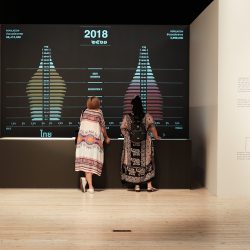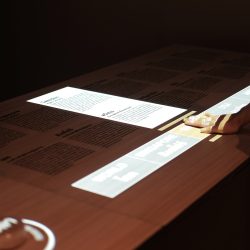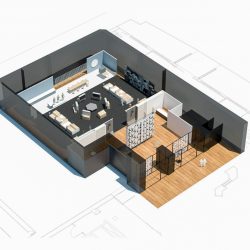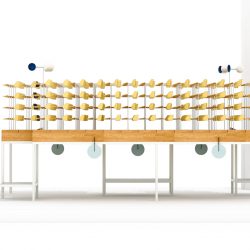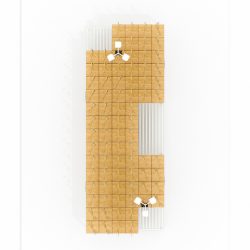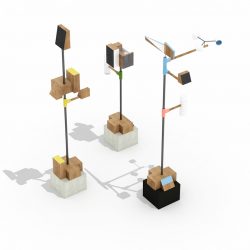FOR SARANON LIMPANANON AND ONN- RACHASIRI SONGSRI, IT IS THE COMBINATION OF ART AND SCIENCE WITH THE BEAUTY OF DESIGN AND ENGINEERING THAT MAKE THEM FLY…
After receiving his interior architecture degree, Saranon Limpananon’s personal interest in technology was furthered through accumulation of knowledge and skills in basic program writing, all of which were the results of self-learning. He later pursued such interest in New York where he studied the realm of New Media while gaining working experiences in design. Saranon then began his career working in the Interaction Design Unit at Smart Design before later working with Masamichi Udagawa for a total period of three years. Living and working in New York introduced him to Onn-Rachasiri Songsri, a former economics student who had furthered her studies in Interior Design and been working as a professional interior designer in a New York-based interior design firm for 6 years.

New Aged Citizens (2016) exhibition at TCDC, Image © Studio Aeroplane
“The problem with working in other people’s companies is that we have to learn to understand the vision of our superiors, which makes it hard for us to be able to create the kind of work we want to do or things we find interesting. And, after a while, it’s time for you to choose whether you’re going to go on doing that for the long run, or quit and start your own firm. Another reason is the fact that I had been living abroad since I was young, and I had this idea to come back to Thailand to learn what it’s like working here, and Onn’s parents were getting old, so coming back home to take care of them was one of our intentions.
Saranon explained the reasons behind their decision to open Studio Aeroplane together in Bangkok in late 2009. The projects they came across in the early days were mostly residential projects and their customer base increased through word of mouth whereas the exhibition design projects and product consultations were the results of the studio’s collaboration with other companies.

New Aged Citizens (2016) exhibition at TCDC, Image © Studio Aeroplane
“The aeroplane has always interested us. It can be a toy for children, a science, a technology, and there are great aesthetic qualities to its form. It’s an invention that combines the beauty of design and rationale of engineering,” one of the founders explained of the idea behind the name Studio Aeroplane.
The studio became more widely recognized through the many exhibition design projects they have done ranging from The World is a Never-Ending Novel (2014), The World of Sriburapha’s Novels Special Exhibition (2014), Good Kid (2015) and A Chronicle of Hope from Womb to Tomb (2016) to Thai Rise (2015) at Frankfurt Book Fair where the studio collaborated with The Publishers and Booksellers Association of Thailand (PUBAT). Studio Aeroplane also worked with TCDC in the making of the exhibition, New Aged Citizens (2016), while their most recent project such as Nawaphol Thamrongrattanarit’s, ‘I Write You A Lot’ (2016), at BANGKOK CITY CITY GALLERY, received overwhelming feedback from the crowds.

Studio Aeroplane, Photo by Ketsiree Wongwan
Not that many people know that besides their exhibition and interior designs, this small studio’s multidisciplinary expertise encompasses land development and sustainability (LEED) consultation and community research as well. The principle that is the essence of Studio Aeroplane is the focus it puts on the design of interactions. Formulated are meaningful experiences between human beings and other things such as objects, spaces, technologies and society as well as contents no matter what the final result of the design may be. And for that matter, Studio Aeroplane is particularly interested in the working process in which their participation often takes place in the initial stage of a project, using research data to specify the direction and understand all the involved stakeholders. While this process takes 10-20% of the time, they try to keep the overall schedule from being affected. Consequentially, the direction is clearly set, as they are able to maintain consistency and effectiveness throughout the entire process.

Studio Aeroplane, Photo by Ketsiree Wongwan
TEXT: WICHIT HORYINGSAWAD
studioaeroplane.com


